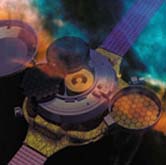|
 "Solar Wind, Genesis, and the Planets" is
divided into pages that make up a unit, or module, of solar
wind study. This module answers some frequently-asked questions,
including: "What can we learn from studying the solar wind?
What is the relationship between solar wind and Solar Max?
What can solar wind data tell us about the Genesis mission?
How does solar wind affect the planets in our solar system?"
"Solar Wind, Genesis, and the Planets" is
divided into pages that make up a unit, or module, of solar
wind study. This module answers some frequently-asked questions,
including: "What can we learn from studying the solar wind?
What is the relationship between solar wind and Solar Max?
What can solar wind data tell us about the Genesis mission?
How does solar wind affect the planets in our solar system?"
The Genesis spacecraft was launched from Cape Canaveral Air
Force Station on August 8, 2001. After a million-mile journey
that took nearly 3 months, the spacecraft went into perfect
orbit insertion about the first Lagrangian point, L1,
the morning of November 16, 2001. In its science collection
phase, the spacecraft is collecting solar
wind particles in hexagonal wafer-shaped collectors made
of very pure silicon, aluminum, gold/platinum, diamond, and
germanium. Also on board is a brand new instrument called
the concentrator.
It has an electrostatic mirror that is designed to focus solar
wind particles on a special chemical vapor deposit (CVD) diamond
and silicon carbide surface. This instrument will also collect
solar wind particles and specific elements of solar wind,
which will enable collection of a more dense concentration
of oxygen and its isotopes.
Analysis of the solar wind plasma
collected by the Genesis spacecraft will enable scientists
to better understand the composition of the original solar
nebula. It is thought that most of the composition of
that nebula has been preserved in the outer layers of the
sun, so the constituents in the solar wind, which flows from
the sun's corona,
are presumed to be very similar to the material from which
our solar system was formed.
CONTINUE in the public module
"Solar Wind, Genesis, and the Planets."
Information on the Genesis Mission: http://www.genesismission.org/mission/index.html
Classroom materials related to the spacecraft's journey:
http://www.genesismission.org/educate/scimodule/Destination_L1.html
Design details and classroom materials focusing on the Genesis
collector: http://www.genesismission.org/educate/scimodule/CleanRoom.html |
